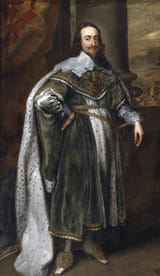Search Results
7/2/2025, 5:55:58 PM
What kind of man was this tragic king who ended up plunging England into a civil war? Before the storm had darkened him, he was a reasonably good man, a loving son, a surprisingly faithful husband, a loyal friend, a father loved by his children. In early childhood he was plagued by a congential condition that made him unable to walk until age 7. He trained his body to be strong and athletic and by maturity could ride and hunt with the best. He also had a speech impediment and could hardly talk coherently until age 10; his father thought about getting a surgical procedure on his tongue. Charles's speech improved but he was forever plagued by a stammer and had to learn to talk slowly so he could be understood.
He was not originally slated to be king; that would have been his popular older brother Henry, who was to become Henry IX had he not died at age 18, leaving Charles heir to the throne and unjustly suspected of poisoning him, which no doubt darkened his mood. Unlike his jovial father, Charles preferred a somber court and solitude. He was skilled in math, music, and theology, could speak six languages with varying skill levels, loved art and expanded his brother's collection, became a discriminating collector, and a dutiful artistic patron. He invited the Italian painter Orazio Gentileshi to his court, then Rubens, Vandyck, and Frans Hals, who declined and Rubens came chiefly as ambassador but Vandyck became official court painter and produced numerous portraits of the king with his trademark Vandyck goatee.
He was not originally slated to be king; that would have been his popular older brother Henry, who was to become Henry IX had he not died at age 18, leaving Charles heir to the throne and unjustly suspected of poisoning him, which no doubt darkened his mood. Unlike his jovial father, Charles preferred a somber court and solitude. He was skilled in math, music, and theology, could speak six languages with varying skill levels, loved art and expanded his brother's collection, became a discriminating collector, and a dutiful artistic patron. He invited the Italian painter Orazio Gentileshi to his court, then Rubens, Vandyck, and Frans Hals, who declined and Rubens came chiefly as ambassador but Vandyck became official court painter and produced numerous portraits of the king with his trademark Vandyck goatee.
Page 1
